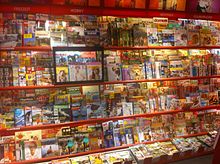Mass Media/Magazines
During the 19th century, magazines were the predominant national medium. (Newspapers were the local medium.)

Magazines are a kind of periodical (along with newspapers), meaning they are published regularly. Common schedules include weekly, biweekly (every other week), monthly, bimonthly (every other month), quarterly, or even annually. The typical magazine is published on paper, usually with a heavier, thicker paper as the cover, although paper quality varies significantly.They are usually bound with either glue or staples. There are some magazines that are only published online, and other experiments happen, such as magazines on CD, or podcasts.
Magazines are distributed in several ways. Magazine issues can be sold individually on the newsstand, including grocery stores. They can also be sold as a subscription where several issues will be delivered by mail for a set fee. Other methods include targeted mailings to particular places, or "dropping" issues in high-traffic places like stores, salons, and doctor's offices.
From an advertising perspective, magazines allow messages to be highly targeted - magazines range from a specialized art publication that may reach 2,000 people to a mass publication that could reach 2-3 million people (People, Time Magazines). Magazines also offer a variety of audiences that may be highly targeted to men (Esquire) or women (Vogue), to luxury (Elite Traveler) to the everyday (Woman's Day). Magazine editorial can range from general (Newsweek) to highly specific (Cat Fancy) which offers lots of options for both consumers and advertisers. Categories include General Interest, Celebrity, Epicurean (food), Lifestyle, Service (advice), Fashion/Beauty, Shelter (home), Art, Music, Entertainment, Regional/Local/City, Business, Newsweekly, Newspaper Supplement, Health, Literary, Alternative/Independent, Travel, and Enthusiast (hobbies). Many of these can be categorized further as men's, women's or teen titles. Some target certain ethnic groups, language groups, or lifestyles.
Trade publications are often expensive for the consumer, but they are highly specific to particular industries, for example, long-haul trucking, steel manufacturing, bar owners, or organic farmers all have magazines dedicated to them.
Magazines are good for advertisers, because they typically cater to a narrow demographic. Since it is easy to discern the audience of most magazines, it makes it easy for advertisers to "target" their ads. Generally, magazine readers are professionals in management, and have higher incomes compared to other media audiences. People pay more attention to magazine advertisements than advertising in any other medium, such as TV, radio, or digital.
The policy of "church and state" is self-regulated by the publishing industry. It means that advertisers should not be allowed to influence the editorial or articles of the magazine and vice versa. Publishers may choose to reject an advertisement or require the page to carry the words "advertisement" or "promotion" if it looks too much like an article.
The magazine publishing industry is mostly self-regulated. Most advertisers voluntarily restrict their messaging about tobacco, alcohol, and increasingly unhealthy food.